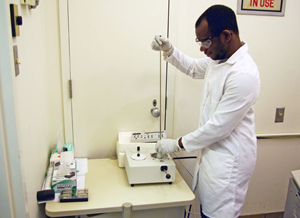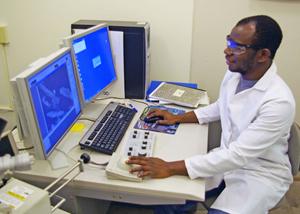
Sehinde, at the Tulane University Coordinated Instrumentation Facility, sits beside the scanning electron microscope he uses to image halloysite nanotubes and oil droplets stabilized by them. (Photo by Chike Ezeh)
An interest in oil spill research led Olasehinde Owoseni from Ile-Ife, an ancient city in Nigeria, to the Louisiana coast. Such a change might seem intimidating, but Sehinde sees it is as a small step toward his greater goal.
His research examines the use of miniscule clay particles for the development of safer and more cost-efficient oil spill remediation technologies.
Sehinde is a chemical and biomolecular engineering Ph.D. student at Tulane University and a GoMRI Scholar with C-MEDS. He explains his research and personal journey as a scientist.
His Path
Sehinde is proud to be a chemical engineer because he feels that transforming natural materials into useful products creates “a vital link between scientific understanding and societal application.” He completed an undergraduate degree at Obafemi Awolowo University – Ile-Ife and began his chemical engineering career at PZ Cussons, an international detergent and cosmetics manufacturer. Working in industry gave him a taste of practical engineering, but he had a deep desire to continue his education. While researching graduate schools, he heard about dispersant technology research at Tulane University led by Dr. Vijay John, director of C-MEDS. Sehinde was eager to take part in the search for more ecofriendly dispersant systems and enrolled in Tulane’s chemical and biomolecular engineering doctoral program. There, he joined the lab of his advisor Dr. John, whose research aims to design the next generation of dispersants.
His Work

Sehinde uses liquid nitrogen to freeze oil droplets stabilized by halloysite nanotubes. Cryogenic imaging of these droplets will allow researchers to visualize the nanotubes and how they attach to the surface of oil dispersed in water. (Photo by Chike Ezeh)
Sehinde’s initial research focused on improving oil dispersants by replacing potentially harmful components with natural materials. Dispersants contain substances that lower surface tension (surfactants) and substances that disperse oil for microbial consumption (solvents). He considered these components’ roles and saw the potential to replace solvents used in existing dispersants with halloysite, a naturally occurring clay composed of tiny nanotubes. “Instead of using completely solid particles, we chose hollow particles that could be filled with surfactant,” he explains. “This is the first time the use of hollow particles has been applied to oil spill remediation.”
Sehinde loaded surfactant into the nanotubes using vacuum suction and then applied them to the surface where oil and water meet. He found that surfactant-loaded nanotubes were more effective at dispersing oil and keeping it dispersed than commercially-available dispersants. The nanotubes released surfactant slowly, creating smaller droplets that are easier for oil-degrading microbes to eat. The nanotubes also linked together across the oil’s surface, which prevented droplets from regrouping into a larger form. Sehinde’s halloysite research resulted in a Langmuir journal article and was featured on the GoMRI website, Study Finds Ecofriendly Clay Delivers and Improves Oil Spill Treating Agents.

Sehinde uses Tulane’s rotary evaporator to load surfactants into halloysite nanotubes through vacuum suction and solvent evaporation. (Photo by Regan Manayan)
The halloysite experiment’s success led Sehinde to consider other ways the clay nanotubes could be used for oil spill response. His current research examines how loading nanotubes with magnetic materials could track oil’s movement through the ocean. The concept is based on nuclear magnetic resonance, which is when atoms in a magnetic field absorb electromagnetic radiation and re-emit it at a specific frequency. Magnetic clay nanotubes applied at the boundary between oil and water may cause oil atoms to respond to a magnetic field differently than bulk ocean water, indicating oil presence. Sehinde is also curious if magnet-loaded nanotubes could be used to help skim surface oil and if loading nanotubes with nutrients could help microbes degrade oil more quickly. “Those are some directions we can go, but we are taking it one thing at a time,” he explains.
His Learning
Working with C-MEDS has shown Sehinde that collaborating and exchanging knowledge are often the driving forces behind scientific discovery. He has enjoyed the C-MEDS research community because it allows him to learn and contribute simultaneously. “I’ve learned a lot about how science moves forward,” he says. “While you learn from people, people also learn from you. You always have to look at new things and think in new ways. This experience taught me how to be a good scientist.” Looking back at what he has learned, his advice to others considering a science career is that “a constant appetite for learning and a passionate commitment to excellence are essential qualities for a scientist.”

Sehinde conducts room temperature imaging of halloysite nanotubes with magnetic materials on the surface. (Photo by Chike Ezeh)
C-MEDS outreach activities have taught Sehinde how to better communicate with young people and stimulate their interest in science and engineering. He participated in middle school and high school outreach visits, explaining why oil spills occur and what might happen if they go untreated. He demonstrated how adding surfactant or particles can help break up oil in water so that the oil mixes with the water. “I did the experiment first,” he explained, “then, I let the students do it so they can see that it’s real – it’s science.” By stimulating student interest in oil spill treatments that incorporate natural materials, Sehinde believes his work to help reduce dispersants’ environmental impacts might gain public support. He had an opportunity to show high school students from a Louisiana fishing community how a single oil spill can have large impacts. This interaction was particularly memorable for Sehinde, “I enjoyed explaining the science and then relating it to their community. That form of outreach has been a really rewarding part of my work.”
His Future
Sehinde’s oil spill research has inspired him to apply his experience in a different field, improving the technology that powers our lives. In the future, he would like to conduct industry research on new and emerging energy systems, “I’d like to create ways to deliver power with minimal environmental impacts and explore alternatives to oil and gas.”
Praise for Sehinde
Dr. John identified determination as the force behind Sehinde’s abilities as a scientist. “He is a highly motivated student,” John said. “He is able to anticipate directions, driven by his own curiosity.” John explained that these characteristics have made Sehinde an important element of his lab, “He has been a joy to work with. The other graduate students in the department view him with much affection and respect. He is a role model for them, mentoring newer students and generating ideas with more senior students, some of which have led to collaborations with my faculty colleagues.”
Despite Sehinde’s strong personal drive, John describes him as being “quiet and scholarly” – someone who speaks through his work. “He thinks very creatively. Oftentimes, when we discuss research and ideas, he surprises me with subtle statements that indicate that he has not only thought of the idea but that he has also done the key experiment to validate his hypothesis,” John explained. “Sometimes, I wish Sehinde would argue a research point with me, but that is simply not his style. He listens, never pushes his opinion, and just quietly does his work. And, when it is done, it is clear that he has thought the problem through.”
John also praised Sehinde’s ability to communicate science effectively. He noted that Sehinde won 2nd place in the American Institute of Chemical Engineers Environmental Division Graduate Student Paper Award, which recognizes outstanding graduate student contributions to environmental protection through chemical engineering.
The GoMRI community embraces bright and dedicated students like Olasehinde Owoseni and their important contributions. The GoMRI Scholars Program recognizes graduate students whose work focuses on GoMRI-funded projects and builds community for the next generation of ocean science professionals.
Visit the C-MEDS website to learn more about their work.
************
This research was made possible in part by a grant from BP/The Gulf of Mexico Research Initiative (GoMRI) to theConsortium for the Molecular Engineering of Dispersant Systems (C-MEDS). The GoMRI is a 10-year independent research program established to study the effect, and the potential associated impact, of hydrocarbon releases on the environment and public health, as well as to develop improved spill mitigation, oil detection, characterization and remediation technologies. An independent and academic 20-member Research Board makes the funding and research direction decisions to ensure the intellectual quality, effectiveness and academic independence of the GoMRI research. All research data, findings and publications will be made publicly available. The program was established through a $500 million financial commitment from BP. For more information, visit http://gulfresearchinitiative.org/.
